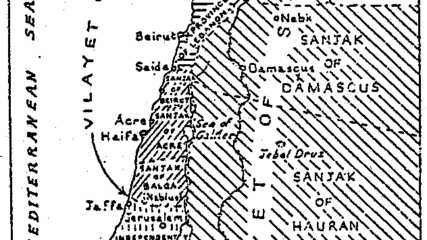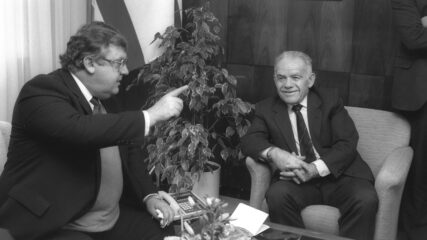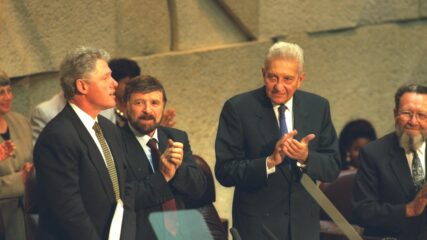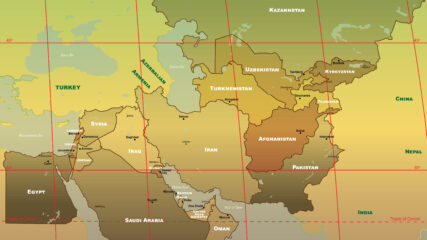November 2, 2020
By Michael Jacobs and Ken Stein
Yitzhak Rabin’s life story, in the words of Israel’s Minister of Diaspora Affairs, 2021, Nachman Shai, is “the story of the State of Israel.” He fought to create and defend it in 1948 and 1967, represented it in Washington, led it twice as prime minister, liberated Jews from captivity in 1945 and 1976, and embraced an opportunity for a chance at a longtime peace with the Palestinians in 1993. Rabin possessed essential qualities of an admired leader: credible, authentic, honest, visionary, and strategic. In addition, Rabin was taciturn, incisive, and suffered no fools. For a lifetime, he put the Jewish people on his shoulders as defender and diplomat.
Rabin possessed an air of authority, but not the charisma associated with Ben-Gurion, Dayan, or Begin. He was meticulous in preparation and thorough in strategic thinking, bold without being reckless. He prepared the pre-emptive military strike for the June 1967 war, when Rabin’s government signed the 1993 Oslo Accords on September 13, 1993, with the PLO, he did so because it was a “future’s option.” A critical prelude to the Accords’ signing was an exchange of letters between the PLO and Israel where each recognized the legitimacy of the other.
Rabin did not promise the Palestinians a state or self-determination; he enabled them self-government, originally promised by Menachem Begin in the 1978 Camp David Accords but not implemented. From that declaration of principles, he wanted to see how the Palestinians would manage themselves and their relationships with Israel in a setting that could possibly expand. He felt it was important to separate Israelis from Palestinians; hence he became an advocate for building the barrier/fence that separated Palestinians from Israelis on the West Bank.
In September 1995, he categorized a Palestinian entity as “pachot me-medina,” less than a state. Rabin never endorsed the idea of a two-state solution, though he believed ultimately Israel would have to reach an accommodation with the Palestinians. Separating geographically from them was the same pragmatic concept that his successor Ariel Sharon applied when Israel withdrew its settlers from the Gaza Strip in August 2005.
November 4 marks the anniversary of his assassination by a right-wing extremist who believed that Rabin was overzealous in his desire to make peace with the Palestinians. His assassin, Yigal Amir, wrongly believed that Rabin was prepared to cede the West Bank, the biblical patrimony of ancient Israel, to foreign sovereignty. Like every Prime Minister before or after him, none of them either ceded or declared Israeli sovereignty over the West Bank (except for parts of Jerusalem), leaving the area’s jurisdiction as an open option for the future.
Rabin was willing to move toward the Palestinians. However, the same commitment was not there for PLO leader Yasser Arafat. We learn from written sources that Arafat was more interested in autocratic rule over the Palestinians and the West Bank than he was interested in reaching a final end-of-conflict agreement with any of the eight Israeli Prime Ministers with whom he had contacts. None other than former Saudi Arabian Ambassador Bandar bin Sultan noted in an October 2020 interview that Arafat rejected every effort to end the conflict with Israel when given ample opportunity by four American presidents.
* * * *
Rabin was the first native of the Land of Israel to serve as prime minister. Born in Jerusalem on March 1, 1922, he grew up in Tel Aviv. And in the summer of 1941 he was one of the first to join the Haganah’s elite strike force, the Palmach. He led a raid in 1945 to free illegal Jewish immigrants who were interned in a British camp in Athlit north of Herzlia. He became a battalion commander by the end of 1946 and the Palmach’s chief operations officer by late 1947.
Before and during the War of Independence, he led efforts to break the Arab blockade of Jewish Jerusalem, and he led the city’s defense early in the war. With some misgivings, he helped the Palmach integrate into the Israel Defense Forces at the orders of Prime Minister David Ben-Gurion in September 1948. Rabin then served as Yigal Allon’s deputy in the IDF’s Southern Command against the Egyptians and participated in 1948-49 war’s cease-fire talks in Rhodes.
A career IDF officer, Rabin missed fighting in the Sinai during the 1956 Suez Crisis because he was with the Northern Command. Rabin then became Chief of IDF Operations, and then in December 1963, Prime Minister Levi Eshkol named him the IDF Chief of Staff, extending his term beyond 1966. Rabin streamlined the army’s operations as an integrated fighting unit and assembled a team of highly competent generals, many of whom had served together since the pre-state period. He is credited, along with Air Force Gen. Ezer Weizman, with designing the operational plans that enabled Israel to gain a pronounced victory in the June 1967 war. The acquisition of all of Jerusalem, the Sinai Peninsula, the West Bank, the Gaza Strip and the Golan Heights altered Israel’s strategic reality down to the present day.
Upon retiring from the IDF at the end of 1967, Rabin entered the diplomatic corps as Israel’s ambassador to the United States during the last year of Lyndon Johnson’s administration and the first term of Richard Nixon’s. Rabin helped ensure that the United States filled the role of Israel’s main arms supplier after France cut off sales in 1967, and he supported U.S. efforts to mediate negotiations between Israel and the new Egyptian government after Anwar Sadat took power in 1970. Those negotiations were not supported by Golda Meir’s government. Peter Rodman, a special assistant to Henry Kissinger, remembered Rabin as “the perfect ambassador” because of his toughness, strategic brilliance and understanding of the superpower rivalry in play in the Middle East. He also said Rabin was always grumpy.
Rabin returned to Israel in spring 1973, joined the Labor Party and won a Knesset seat in the December election, two months after the Yom Kippur War. He joined Meir’s Cabinet as labor minister in 1974, then succeeded her as prime minister when she resigned in April. There were three major highlights of his term: the signing of a first military disengagement agreement with Syria in May 1974, a second military disengagement agreement with Egypt in September 1975, and the successful raid on the Entebbe, Uganda, airport in July 4, 1976, which freed more than 100 hostages taken in an airline hijacking.
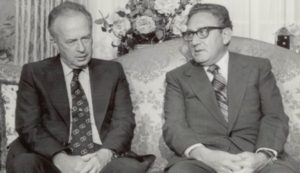
Before the Knesset election in May 1977, a scandal broke over his wife’s retention of an American bank account, violating Israeli law, and Rabin resigned, turning the Labor leadership over to Shimon Peres, his long-term political rival in the Party. By resigning, Rabin demonstrated integrity and accepted accountability. Menachem Begin’s Likud party defeated Peres in the election, and Rabin was out of office when Egyptian President Sadat made his dramatically unexpected visit to Jerusalem in November 1977.

Rabin returned to the Cabinet as the defense minister in unity governments from 1984 to 1990. After the first Palestinian uprising or “intifada” against Israeli control of the West Bank and Gaza Strip began in 1987, he ordered the IDF to respond with force. He learned that Palestinian national aspirations could not be defeated militarily, and he proposed in 1989 that Palestinian elections be held to enact the autonomy provisions of the Camp David Accords, to be followed by final-status negotiations.
After Rabin became prime minister for a second time in June 1992, negotiations with Jordan and Syria continued, but Peres drove secret talks with the PLO. Throughout the negotiations and afterwards, Rabin did not trust the PLO or its leadership. Yet he saw Israel with strength militarily and capable of testing Arafat’s intentions. For Rabin, the PLO-Israel mutual recognition letters were strategically significant; the Oslo Accords signed at the White House were also not only for a trial separation with the Palestinians, but because the letters set up the immediate prospects of Jordan and Israel recognizing each other in their treaty within the year. PLO and Jordanian recognition of Israel in 1993 and 1994, respectively, provided the vital diplomatic precedent for the UAE, Bahrain, and Sudan to recognize Israel diplomatically in 2020.
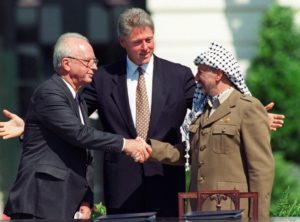
Always the strategic thinker, Rabin believed that the stability of King Hussein’s Jordan was critical for Israel because Jordan was the vital land buffer between Israel and Iraq/Iran on Israel’s eastern flank. He understood that the mutual PLO-Israel recognition had great meaning for other Arab countries, particularly Jordan. The Jordan-Israel Treaty was signed October 26, 1994, with Hussein and Rabin embracing as two grizzled veterans of Middle Eastern history and politics.

As for Syria, Rabin continuously sought a way to negotiate with the Syrian regime of Hafez al-Assad but did not succeed because Assad wanted areas around the Sea of Galilee that would have jeopardized Israeli security and continued control over the headwaters of the Jordan River, which fed Israel’s National Water Carrier.
Rabin was “a soldier in the army of peace,” as he referred to himself in a July 1994 speech to the U.S. Congress, but observers of Arab-Israeli negotiations then and since have questioned whether he could have achieved that peace if he had lived. The absence of an unequivocal Palestinian political embrace of Israel has added enormous substance to the claim that even if he had lived, or if he had been succeeded by centrist or left-of-center Israeli leaders, an end to the conflict was not possible because courageous, strong and visionary leaders were not present on the Palestinian side to test Israeli politicians with similar leadership qualities.
Further Reading on Rabin – Analyses, Documents, Videos, Biographies
• Rabin expresses ambivalence about integrating the Palmach into the Israel Defense Forces in September 1948, israeled.org/palmach-integrates-idf
• June 28, 1967, Rabin explains the IDF’s dedication and success while accepting an honorary doctorate, israeled.org/resources/documents/israeli-chief-staff-yitzhak-rabin-right-israel
• September 1975, President Ford promises Rabin/Israel that any future peace agreement with Syria peace agreement will ensure Israel’s protection from attack from the Golan Heights, even if that means Israel keeps the Golan, israeled.org/resources/documents/promises-golan-heights-future-pres-ford
• September 9, 1993, Israel and the PLO exchange letters of recognition, israeled.org/resources/documents/israel-plo-mutual-recognition-letters
• September 13, 1993, the Oslo Accords are signed at the White House, israeled.org/resources/documents/oslo-accords
• October 5, 1995, Rabin shares his vision of the State of Israel in most of the British Mandate alongside “a Palestinian entity,” among eight decades of statements on a possible two-state solution, israeled.org/historical-statements-on-a-two-state-solution
• November 1, 1995, Rabin tells his speechwriter that he made an agreement with Arafat’s PLO to bolster secular Palestinian identity, fearing the religious growth of Hamas, israeled.org/resources/documents/yitzhak-rabin-oslo-accords
• November 1, 1995, Rabin discusses Lebanon, Syria, the Palestinians and the viciousness of his political opponents three days before his assassination, israeled.org/interview-with-israeli-prime-minister-yitzhak-rabin-discussing-lebanon-syria-palestinian-track
• March 1996, the Shamgar Commission reports on the Rabin assassination, israeled.org/resources/documents/shamgar-rabin-assassination
• September 2018, on the 25th anniversary of the Oslo Accords, the Israeli delegation’s legal adviser, Joel Singer, looks back at the successes and failures, israeled.org/twenty-five-years-since-oslo-an-insiders-account
• February 4, 2020, Dan Diker of the Jerusalem Center for Public Affairs explains Rabin’s doctrine of defensible borders in the context of the Trump peace plan, israeled.org/the-u-s-peace-plan-a-return-to-the-rabin-doctrine-of-defensible-borders
Important Videos About Yitzhak Rabin and His Life
• 92nd Street Y, “Remembering Yitzhak Rabin” (Itamar Rabinovich, Dalia Rabin with Peter Rubinstein), March 6, 2017 (1:00:39), www.youtube.com/watch?v=CJorltqRbuY
• Brookings Institution, “Yitzhak Rabin: Soldier, Leader, Statesman” (Bill Clinton, Martin Indyk, Itamar Rabinovich, Dalia Rabin), March 10, 2017 (1:24:55), www.youtube.com/watch?v=t5-8s7v2_f8
• Council on Foreign Relations, “The Life and Legacy of Yitzhak Rabin — 25 Years Later” (Martin Indyk, Marwan Muasher, Itamar Rabinovich), October 30, 2020 (1:00:24), www.youtube.com/watch?v=i6UCrO7Ufqg
• University of Arizona Center for Judaic Studies, “Rabin’s Assassination: A Turning Point in Israeli History” (Itamar Rabinovich), March 13, 2018 (39:16), www.youtube.com/watch?v=4iWopl0Iais
Key Rabin Speeches Archived at the Rabin Center
www.rabincenter.org.il/Web/En/Archives/1/Speeches/Default.aspx.
Biographies
• Rabin, Leah. Rabin: Our Life, His Legacy. New York, NY: G.P. Putnam’s Sons, 1997.
• Rabin, Yitzhak. The Rabin Memoirs. Boston, MA: Little, Brown, and Company, 1979.
• Rabinovich, Itamar. Yitzhak Rabin: Solder, Leader, Statesman. New Haven, CT: Yale University Press, 2017.
• Ross, Dennis and David Makovsky. Be Strong and of Good Courage, Chapter 3, New York, NY: Hatchette Book Group, 2019.


